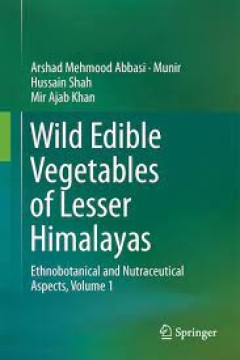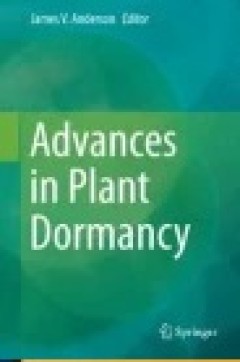Filter by

Wild Edible Vegetables of Lesser Himalayas Ethnobotanical and Nutraceutical …
Our intention with this book was to present the reader with the most accurate, significant, and up-to-date background and knowledge in the areas of ethnomedicinal and nutraceutical vegetation for the Lesser Himalayas in a comprehensive text. Wild Edible Vegetables of Lesser Himalayas provides a complete review of over 50 important plants of this region and details each species including photogr…
- Edition
- -
- ISBN/ISSN
- 978-3-319-09543-1
- Collation
- XVII, 360
- Series Title
- -
- Call Number
- -

Medicinal and Aromatic Plants of the World
Medicinal and aromatic plants (MAPs) have accompanied mankind from its very early beginnings. Their utilization has co-evolved with homo sapiens itself bringing about a profound increase in our scientific knowledge of these species enabling them to be used in many facets of our life (e.g. pharmaceutical products, feed- and food additives, cosmetics, etc.). Remarkably, despite the new renaissanc…
- Edition
- 1
- ISBN/ISSN
- 978-94-017-9809-9
- Collation
- VIII, 460
- Series Title
- Medicinal and Aromatic Plants of the World
- Call Number
- -

Advances in Plant Dormancy
Plant dormancy involves synchronization of environmental cues with developmental processes to ensure plant survival; however, negative impacts of plant dormancy include pre-harvest sprouting, non-uniform germination of crop and weed seeds, and fruit loss due to inappropriate bud break. Thus, our continued quest to disseminate information is important in moving our understanding of plant dormanc…
- Edition
- Ed. 1
- ISBN/ISSN
- 978-3-319-14451-1
- Collation
- XIV, 311
- Series Title
- -
- Call Number
- 581.5 ADV a

Advances in New Technology for Targeted Modification of Plant Genomes
Over the past 50 years, biotechnology has been the major driving force for increasing crop productivity. Particularly, advances in plant genetic engineering technologies have opened up vast new opportunities for plant researchers and breeders to create new crop varieties with desirable traits. Recent development of precise genome modification methods, such as targeted gene knock-out/knock-in an…
- Edition
- Ed. 1
- ISBN/ISSN
- 978-1-4939-2556-8
- Collation
- VIII, 166
- Series Title
- -
- Call Number
- 631.5233

Evolutionary Ethnobiology
Ethnobiology is a fascinating science. To understand this vocation it needs to be studied under an evolutionary point of view that is very strong and significant, although this aspect is often poorly approached in the literature. This is the first book to compile and discuss information about evolutionary ethnobiology in English.
- Edition
- -
- ISBN/ISSN
- 978-3-319-19917-7
- Collation
- VIII, 204
- Series Title
- -
- Call Number
- -

Natural UV Radiation in Enhancing Survival Value and Quality of Plants
This book is the first of its kind to highlight the positive impact of natural UV radiation on plants through unique adaptations in various metabolic pathways, and provides an evolutionary sketch of the development of molecular mechanisms for protecting plants from solar UV ever since their migration to terrestrial habitats. Experimental evidence is provided for establishing how plants, through…
- Edition
- 1
- ISBN/ISSN
- 978-81-322-2765-6
- Collation
- XIX, 204
- Series Title
- -
- Call Number
- -

Elucidation of Abiotic Stress Signaling in Plants Functional Genomics Perspe…
Abiotic stresses such as high temperature, low-temperature, drought, and salinity limit crop productivity worldwide. Understanding plant responses to these stresses is essential for rational engineering of crop plants. In Arabidopsis, the signal transduction pathways for abiotic stresses, light, several phytohormones and pathogenesis have been elucidated. A significant portion of plant genomes …
- Edition
- 1
- ISBN/ISSN
- 978-1-4939-2540-7
- Collation
- 1 b/w illustrations, 26 illustrations in colour
- Series Title
- -
- Call Number
- -

Elucidation of Abiotic Stress Signaling in Plants Functional Genomics Perspe…
Abiotic stresses such as high temperature, low-temperature, drought, and salinity limit crop productivity worldwide. Understanding plant responses to these stresses is essential for rational engineering of crop plants. In Arabidopsis, the signal transduction pathways for abiotic stresses, light, several phytohormones and pathogenesis have been elucidated. A significant portion of plant genom…
- Edition
- 1
- ISBN/ISSN
- 978-1-4939-2211-6
- Collation
- 6 b/w illustrations, 29 illustrations in colour
- Series Title
- -
- Call Number
- -
 Computer Science, Information & General Works
Computer Science, Information & General Works  Philosophy & Psychology
Philosophy & Psychology  Religion
Religion  Social Sciences
Social Sciences  Language
Language  Pure Science
Pure Science  Applied Sciences
Applied Sciences  Art & Recreation
Art & Recreation  Literature
Literature  History & Geography
History & Geography